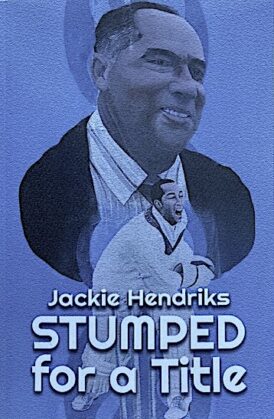Stumped for a Title
Martin Chandler |Published: 2025
Author: Hendriks, Jackie
Publisher: Ian Randle Publishers
Rating: 3 stars

It isn’t often you get a first book from a nonagenarian, and an autobiography at that. But that is what 1960s West Indies wicketkeeper Jackie Hendriks has produced with Stumped for a Title. It isn’t quite perfect, but its strengths certainly outweigh its weaknesses, and overall it is a thoroughly worthwhile read.
A Jamaican, Hendriks played in 20 Tests and, in the mid 1960s, was West Indies first choice keeper, but his career has a slightly odd look about it, and some elaboration on one or two aspects of it would have been very welcome.
The book is very much a cricketing biography, so while Hendriks does deal with his childhood and his development as a cricketer there is little of his personal life outside that. He made his First Class debut in 1954, but didn’t play his second First Class match for another four and a half years. Despite that he was invited to the trials that took place to assist in selecting the 1957 touring party to England and whilst he didn’t make that after just one more First Class appearance he was taken to India and Pakistan in 1958/59.
Hendriks didn’t play a Test in those series, nor in Australia where he was the second keeper again in the historic 1960/61 series. As much as a quarter of the book is taken up with an account of the series of the first tied Test, and it is an excellent analysis from a man who sat through all five matches. It was to be a year later that Hendriks finally did make his Test debut, at home against India.
Unfortunately for Hendriks he broke a finger early in the match, although that did not stop him batting and making 64, a score that was to remain his best in Tests. A useful batsman rather than anything approaching a genuine all-rounder Hendriks’ views on the age old debate about whether the best keeper should always be selected are unsurprising, but entirely convincing.
There follow chapters on each of the Test series that Hendriks was involved in, so at home against Australia in 1964/65, in England in 1966, India in 1966/67 and in Australia and New Zealand in 1968/69. All those tours are interesting, and most particularly that to India which has never been the subject of a book. Hendriks description of the players’ reaction when members of the crowd rioted at Eden Gardens is of particular interest.
So returning to the point made earlier what would I have liked to have read more about? First of all I would have been interested in learning more about Hendriks’ views on the controversy over the legality of Charlie Griffith’s action. He also makes no reference to the 1963 tour of England and the reasons why he played no part in that.
When Hendriks was established West Indies had a number of ‘keepers available to them, David Allan, Deryck Murray and Ivan Mendonca all being selected during Hendrik’s tenure, yet he does not have a great deal to say about them, which is particularly odd as he does spend some time looking at the previous generation of West Indies ‘keepers, those vying for the position in the late 1950s and early 1960s.
And what of the end of Hendriks’ career? He goes straight from the visit to New Zealand to his final chapter, Life After Cricket. There is therefore no explanation of the reason for a retirement that came at the end of the tour of England in 1969. There is nothing in the book about the decision to give up and the reference to Hendriks in Wisden’s report of the trip serves only to heighten my curiosity, Hendriks came as the number one wicketkeeper, but he had unsatisfactory first Test … Following that Test he played against Surrey and then Leicestershire, but that was Hendrik’s First Class career over.
The final chapter is also rather shorter than I expected given that, post retirement, Hendriks had a long career as an administrator. He managed the immensely powerful West Indies squads that swept all before them in England in 1984 and 1988 and was later the match referee in 19 Tests and 26 ODIs so I have little doubt that rather more than nine pages should be required in order to do justice to the best part of sixty years. Indeed it is realistically only eight if Hendriks’ reworking of the lyrics to Frank Sinatra’s famous song My Way are disregarded, although I stress that unusual ending is one I much enjoyed.






Leave a comment